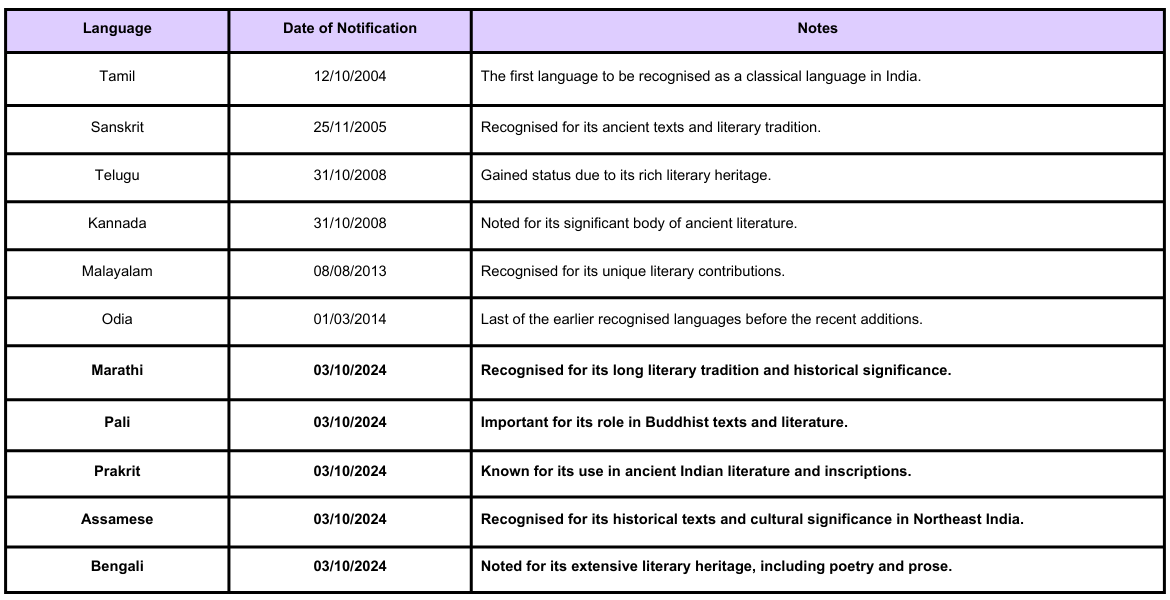. 05/10/2024 4:23 PM
Why in the News?
On October 3, 2024, the Union Cabinet of India announced the addition of five new languages to its list of classical languages: Pali, Prakrit, Marathi, Assamese, and Bengali. This decision increases the total number of recognized classical languages in India to eleven, which already includes Tamil, Sanskrit, Telugu, Kannada, Malayalam, and Odia. The extension of the “classical language” tag to these five languages reflects the Indian government’s commitment to preserving and promoting linguistic diversity and cultural heritage. This recognition aims to enhance the study, research, and appreciation of these languages and their literary traditions.

A Classical language in India is defined as a language that possesses an independent literary tradition and a substantial body of ancient written literature. These languages are historically significant and often associated with rich cultural heritages. While they may no longer be widely spoken, they continue to influence modern languages and literatures. Classical languages serve as crucial links to India’s past, preserving the achievements of earlier civilizations.
The idea of classifying languages as "classical" emerged in response to demands from various states. In 2004, the Indian government established the category of classical languages and set forth criteria for this designation. Tamil became the first Indian language to receive the status on October 12, 2004, due to its long history and rich literary tradition. Following Tamil, Sanskrit was declared a classical language on November 25, 2004, with Telugu and Kannada added in 2008, Malayalam in 2013, and Odia in 2014.
In July 2024, the Linguistic Experts Committee (LEC) revised the criteria for a language to be designated as classical. The updated criteria include:
High Antiquity: The language must have documented texts with a history spanning 1500 to 2000 years.
Cultural Heritage: There must be a substantial body of literature considered valuable heritage by generations of speakers.
Epigraphic Evidence: The language should have historical inscriptions supporting its usage.
Knowledge Texts: Presence of prose texts in addition to poetry is essential.
Distinctness: The classical form of the language should be distinct from its modern forms or derivatives.
Following the new criteria, the committee recommended adding the five new classical languages, a proposal that had been pending with the Centre for several years. This was approved by the Union Cabinet recently.
Prakrit and Pali: Prakrit refers to a group of closely related Indo-Aryan languages spoken by the masses, contrasting with Sanskrit, which was reserved for the elite. These vernaculars were instrumental in the spread of religions like Jainism and Buddhism. Pali, derived from Magadhi Prakrit, became the language of the Theravada Buddhist Canon and remains in use in countries like Sri Lanka and Myanmar.
Marathi: The inclusion of Marathi comes after a proposal from the state government in 2013. Modern Marathi evolved from Maharashtri Prakrit, a dialect historically significant in western India. The earliest evidence of this language dates back to a 1st-century BCE stone inscription in Pune, with modern Marathi traced back to a 739 CE copper-plate inscription in Satara.
Bengali and Assamese: The state governments of West Bengal and Assam had sought classical status for their languages. Both languages originated from Magadhi Prakrit, which was used as the official language of the Magadha court. The emergence of Bengali and Assamese is debated among scholars, with estimates ranging from the 6th to 12th centuries.
The designation of classical languages carries several important implications:
Cultural and Academic Impact: It promotes the preservation of linguistic heritage and enhances research initiatives across disciplines.
Educational Initiatives: The Ministry of Education has committed to promoting classical languages through the establishment of universities and centers for excellence dedicated to their study and preservation.
National Collaboration: Enhanced cooperation between the Ministry of Culture, Ministry of Education, and state governments will focus on research, knowledge-sharing, and digitization of manuscripts to improve accessibility for scholars.
Conclusion
The recent inclusion of Marathi, Pali, Prakrit, Assamese, and Bengali as classical languages is a significant step towards recognizing and preserving India's rich linguistic heritage. It not only honors the historical and cultural contributions of these languages but also paves the way for their future study and appreciation on both national and international stages.